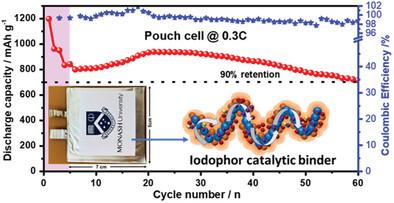当前位置:
X-MOL 学术
›
Adv. Energy Mater.
›
论文详情
Our official English website, www.x-mol.net, welcomes your
feedback! (Note: you will need to create a separate account there.)
Role of Polymer‐Iodine Complexes on Solid‐Liquid Polysulfide Phase Transitions and Rate Capability of Lithium Sulfur Batteries
Advanced Energy Materials ( IF 24.4 ) Pub Date : 2024-11-15 , DOI: 10.1002/aenm.202403092 Maleesha M. Nishshanke, Petar Jovanović, Manas R. Panda, Md. Joynul Abedin, Declan McNamara, Matthew R. Hill, Joydipto Bhattacharya, Chinnathambi Kamal, Mahdokht Shaibani, Mainak Majumder
Advanced Energy Materials ( IF 24.4 ) Pub Date : 2024-11-15 , DOI: 10.1002/aenm.202403092 Maleesha M. Nishshanke, Petar Jovanović, Manas R. Panda, Md. Joynul Abedin, Declan McNamara, Matthew R. Hill, Joydipto Bhattacharya, Chinnathambi Kamal, Mahdokht Shaibani, Mainak Majumder

|
Lithium–sulfur (Li–S) batteries are considered as a viable technology offering energy‐dense electrochemical energy storage systems. However, the inherently slow reaction kinetics manifested in the slow charge and discharge characteristics constrain their real‐world applications. Here, it is reported that polyiodide species held within a complex polar network of polyvinylpyrrolidone (PVP) accelerate the rate‐limiting solid‐liquid phase transitions both in the reduction and oxidation steps during battery cycling. Density functional theory calculations support a mechanism in which a combination of enhanced binding of polysulfides and additional energy states in the PVP‐iodine‐polysulfide complexes accelerates the reaction pathways mediated by inter‐valance polyiodide reactions within the working voltage of Li–S batteries. These studies show that PVP‐iodine (PVP‐I) complexes enhance the rate capability of cells with practical sulfur loadings delivering a high areal capacity of ≈7 mAh cm−2 at the practical 0.5C rate. This advantage is demonstrated in one of the highest‐rate pouches reported in Li–S literature, attaining energy densities of 215 and 156 Wh kg at 0.1C and 0.3C, respectively. The results demonstrate a subtle but powerful shift in the design of molecular binder systems, which have functional roles above and beyond the role of simply holding the active materials together.
中文翻译:

聚合物-碘配合物对锂硫电池固-液多硫化物相变和倍率能力的影响
锂硫 (Li-S) 电池被认为是一种可行的技术,可提供能量密集的电化学储能系统。然而,慢速充电和放电特性所表现出的固有慢速反应动力学限制了它们在实际领域的应用。在这里,据报道,在聚乙烯吡咯烷酮 (PVP) 的复杂极性网络中保持的聚碘化物物质加速了电池循环过程中还原和氧化步骤中的限速固液相变。密度泛函理论计算支持一种机制,其中多硫化物的增强结合和 PVP-碘-多硫化物复合物中的额外能态相结合,加速了 Li-S 电池工作电压内价间聚碘化物反应介导的反应途径。这些研究表明,PVP-碘 (PVP-I) 复合物增强了具有实际硫负载的电池的倍率能力,在实际 0.5C 速率下提供 ≈7 mAh cm-2 的高面容量。这一优势在 Li-S 文献中报道的最高速率袋之一中得到了证明,在 215C 和 156C 时分别达到 0.1 和 0.3 Wh kg 的能量密度。结果表明,分子结合剂系统的设计发生了微妙而强大的转变,其功能作用超越了简单地将活性材料固定在一起的作用。
更新日期:2024-11-15
中文翻译:

聚合物-碘配合物对锂硫电池固-液多硫化物相变和倍率能力的影响
锂硫 (Li-S) 电池被认为是一种可行的技术,可提供能量密集的电化学储能系统。然而,慢速充电和放电特性所表现出的固有慢速反应动力学限制了它们在实际领域的应用。在这里,据报道,在聚乙烯吡咯烷酮 (PVP) 的复杂极性网络中保持的聚碘化物物质加速了电池循环过程中还原和氧化步骤中的限速固液相变。密度泛函理论计算支持一种机制,其中多硫化物的增强结合和 PVP-碘-多硫化物复合物中的额外能态相结合,加速了 Li-S 电池工作电压内价间聚碘化物反应介导的反应途径。这些研究表明,PVP-碘 (PVP-I) 复合物增强了具有实际硫负载的电池的倍率能力,在实际 0.5C 速率下提供 ≈7 mAh cm-2 的高面容量。这一优势在 Li-S 文献中报道的最高速率袋之一中得到了证明,在 215C 和 156C 时分别达到 0.1 和 0.3 Wh kg 的能量密度。结果表明,分子结合剂系统的设计发生了微妙而强大的转变,其功能作用超越了简单地将活性材料固定在一起的作用。


















































 京公网安备 11010802027423号
京公网安备 11010802027423号